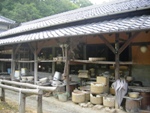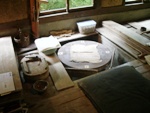The first ceramics in Japan: Jomon Ware
The very first examples of earthenware in the world were produced 12,000 years ago in the form of Jomon Ware, Japan’s very first ceramic products. Various kinds of pottery were produced ranging from products rolled in straw rope to produce patterns to figurines. Baked in open-air fires at comparatively low temperatures, the heat produced results that were thick but brittle and easy to shatter.
Before long though, a method was brought over from the Korean Peninsula, and a great change began to materialize in the shape of earthenware. Different from the complex forms of Jomon Ware, the new products were streamlined and simple structures. This was Yayoi Ware.

The emergence of the kilns
The techniques of Sue Ware were introduced from the Korean Peninsula in which pottery was made with a potter’s wheel and fired in a kiln at high temperatures. From this, many kinds of pottery, such as jars, earthenware vessels for alcoholic beverages, and wares with a horse or pagoda motif could be made which were unlike the examples of earthenware that had been made up to that time. They were frequently used as burial accessories.
The Beginning of Glazing
On entering the Asuka Era (circa 7th century AD), a new technique was introduced from the Korean Peninsula. This method, incorporating the use of a glaze with molten lead, was available for the first time in Japan. Certain ingredients included in the lead turned green so that the parts which were solely covered in the glaze could change color. Furthermore, on entering the Nara Era, the number of colors also increased to include yellow-brown and white. Pottery with a bright, glossy finish could be produced. At that time, quite a wide variety of products such as alcohol vessels, jars, bowls and plates were able to be made.

The Prosperity of Regional Kilns
In the Heian Era, when politics were about to be based on a legal code system, regions began to wield power, and in addition to that, kilns in those areas developed rapidly. Aichi Prefecture’s Sanageyou Kiln and Gifu Prefecture’s Minoyou Kiln, places that are even prospering today through pottery, began their growth at that time. From the beginning, Sanageyou, favoured by the ruling class of nobility and warriors, steadily gained daily use by the masses, and came to produce plates called yamachawan (literally translated as “mountain bowls”) in large quantities. The glaze that had been used up to that time started to decline in usage. Among the kilns for the yamachawan, the ones that especially rose in prominence were the Tokoname and Atsumi kilns of Aichi Prefecture. Incidentally, the reading of yamachawan was derived from the fact that there were so many bowls produced that shards of the bowls could be easily found in the mountains.
Ceramics as High-Quality Items
As mentioned before, the Tokoname and Atsumi kilns, representing yamachawan, developed from Sanageyou to produce daily-use ceramics for regular people. However, to regain its past glory, Sanageyou started manufacturing glazed pottery again from the beginning of the Kamakura Era, and accomplished a renaissance of Setoyaki as high-quality ceramics. Setoyaki, which can also be alternately known as Setomono, was being developed even after the beginning of the Muromachi Era.
Large Pots Flourish
One of the characteristics of Muromachi Era pottery is that large pots were possibly assembled together. But though “large pots” is said as one expression, there were differences in the natural glazing colors as well as the burnishing depending on the pottery town (within the kiln, the wood ashes adhered to the pottery, and they melted at a high temperature), and characteristics began to appear on them. Within those characteristics, one involved the large pots of Bizen in which the name of the creator and the vintage were stamped thereby providing an awareness of their creator. In addition, along with the large pots, the variation in flower vases and teapots also increased, and high-quality items were produced alongside the daily-use items.
The Tea Ceremony and Ceramics
Entering the Momoyama Era, the point was reached in which pottery with a different shape that hadn’t been seen before started to be made. This was “Chatou”. Because of Sen-no-Rikyu, the man who greatly developed the tea ceremony which honored the spirit of Japanese refinement, teacups were made so that they became implements of the tea ceremony. Unlike the trend in ceramics where techniques had been developed and passed on from the Korean Peninsula and China up to that time, it can be perceived that its expansion could be realized in tandem with the development of Japanese culture. Due to this, Bizen Ware and Shigaraki Ware could realize great development.
Further Development
The world of surprisingly drab teacups welcomed the emergence of a new technique. This was glazed decoration. Glazed decoration involved the drawing of pictures and designs after an unglazed work had been fired before glaze was applied. However, the mixing of red clay into the body of the pottery, and the application of pictures and designs firmly increased its expressiveness. The use of various glazes for different purposes meant that a single body of work could be expressed as a work of multiple colors. In addition, the introduction of tea ceremony utensils with intentionally crooked shapes represented a huge change.
The Birth of Porcelain
Because of the influx of potters from the Korean Peninsula at the beginning of the Edo Era, the first examples of porcelain were successfully created. Since this happened in the town of Arita, Saga Prefecture, this is the origin of Arita Ware. In addition, because it was exported abroad from the port of Imari, it also has the alternate name of Imari Ware. In contrast with pottery using clay as its raw material, porcelain used a white stone called touseki as was first explained. However, it was clear that the patterned porcelain brought in from Jindezhen, China was known as something that was new and vastly different from the other types of porcelain up to that time. As well, techniques of adding pictures after the application of glaze were often used, and there were developments in akae (late 19th-century woodblock prints established by Kakiemon Sakaida), colors, and furthermore, techniques often used to draw with many colors such as dark green, purple and yellow. Pottery started emerging with a different feel compared to its predecessors.
Towards ornamental porcelain goods
Entering the Meiji Era, doll-like porcelain goods which emulated the human shape, pots, decorative plates and other ornaments…the number of complex figures increased in number; not only everyday goods of necessity but also the high-quality porcelain goods hit a peak in their manufacture. In addition, goods meant to be exported overseas had their own desired designs printed at the export site with the result being that gifts could be exchanged between countries.
As works of art
Artisans who studied overseas and took Western culture to heart could absorb new points of view which had been absent in ceramics in Japan up to that point. That meant that works without a practical use could be manufactured as goods to be appreciated aesthetically. The custom of manufacturing works of bird or animal motifs that had previously no practical use but could be seen as works of art was said to be a characteristic of the Taisho Era.

The trend of learning from the past
While china was developing rapidly, because of the rediscovery of the old pottery studios, there was also a rebirth of the old ceramics. At the time, in contrast with mainstream china, a wave of bringing back simple and practical pottery as tea utensils and the beauty of glazing also emerged.
The expression of individuality
Bringing together pottery and porcelain goods, when various tastes in works emerge, artists devote themselves to creating things that serve as a medium for their own sensitivity and individuality. The artists who have visited each country in the world and learned various ideas and techniques haven’t just taken in size, shape and methods but they have also become able to express themselves through their creations. This trend still holds sway even today as ceramics are treated more richly than the daily goods they are.
